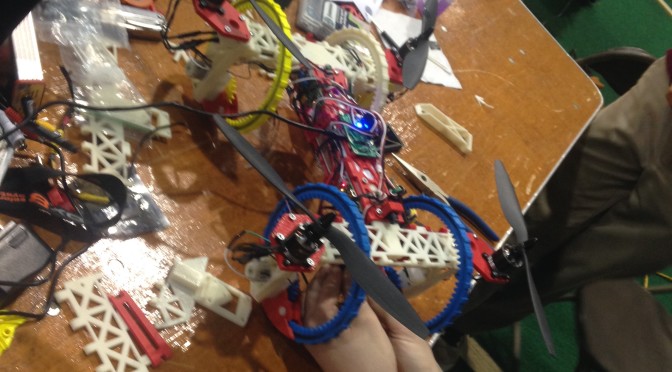
Skills used:
Mechanical Engineering, CAD design, Basic FEA, Intensive Design for Additive Manufacturing.
Description:
Whew, it has been a while since I have posted anything, but rest assured, it’s because I have been too busy to post, not because I haven’t been doing anything.
When I wasn’t doing classes, or working in the makerspace I run, I have been, for the greater part of last semester, working on building a 3D printed drone that can both fly and drive.
How the hell did I get myself in this position? Well….
Back in Feburary, the Virginia Tech DREAMS Lab, which is the university’s Additive manufacturing lab, announced theAdditive Manufacturing Grand Challenge, which was to use CAD systems and our own knowledge and skills to make a vehicle that could drive and fly for disaster relief missions made almost entirely by 3D printing technology.
In the Frith Lab, the Makerspace in which I work as the Lead Lab assistant, one of my cohorts suggested making a team to compete, since we had some serious experience with the printers in our lab. I gathered a few of the ULAs and a couple of freshmen to assist, and, as I was the manager of the lab already, I was volun-told to be team lead. This year, competition was fierce. 70 teams entered the competition (many were graduate student teams), and although many hit trials and tribulations along the way and dropped out, somewhere around 45 were competing for 10 spots in the finals during a elimination round. Since we had a fairly good idea how to work with 3D printers (some of us had built our own), what could possibly go wrong?
Everything went wrong. After numerous redesigns, breakthroughs, team agreements, arguments, prototypes and lost sleep, we finally had something polished enough to go to the judges with. Being that we were a team of almost entirely freshmen, we lacked skills in FEA, and bumbled our way through the process by printing parts and putting them in our Instron tensile testing machine to get some sort of data. When it came time to present, we gave our spiel and left, pulling our hair out for the next 5 hours waiting for a decision.
After enough coffee and anxiety to kill a small animal, we got word back: <hackervoice>We’re in!</hackervoice> We started gearing up to finish the files and get them all submitted. The final result, a vehicle we jokingly referred to as the “Frith Prints of Bel Air,” was fairly impressive.
The best part, was that due to our knowledge of the threshold angle (the angle the printer stops printing support material), which we call the “magic angle.” We allowed the entire vehicle to be printed on ANY well-calibrated FDM printer, instead of just a $200,000 SLS printer.
We handled the obstacles really well, and had a few perfect scores. When it came to the integrated obstacle course, we were pretty hyped up and feeling good about ourselves when we spun up our rotors to fly through a window.
But suddenly, catastrophe. The wall sucked our vehicle towards it, clipping the rotors, and causing the entire vehicle to split into three pieces.
We rushed our vehicle to the ER, and dissembled the thing and re-assembled it from some scrap pieces. Our fatalistic pilot was sure that we were finished, given that the vehicle could not be stabilized with the pieces we had remaining. After some intense argument and convincing, we used some ingenuity and a soldering iron to weld together the broken plates, and by the next challenge, we managed to have a working vehicle again.
We scrapped together some points, and when it came to another window, we once again got sucked in and destroyed. This time though, we were ready, and we had the vehicle repaired and flying again within 2 minutes.
The final challenge was the deadlift, where we had 3 attempts to lift as much as possible. By now, the judges had been whispering that they wanted to see our team continue, as our team dynamic was both scratchy and scrappy, but some somehow effective. Since we had 10” propellers, we could do fairly well, but because our vehicle was damaged, we didn’t exactly know the lifting capacity. Having broken the vehicle twice already, our pilot was understandably cautious to not put too much weight on it. To which I called to him, and said “What’s the worst that can happen? We’ll break it! AGAIN!” After disconnecting on attempt 1, and securing 2 lbs of lift on attempt 2, we decided to go for broke, and put as much weight as possible on it for the last attempt, which accounted to close to 5 lbs. We gunned it, and just barely did not get the points, as it did not go quite high enough. Regardless, we placed second in the deadlift category.
After all was said and done, we managed to obtain the title “Zombie Car,” after our vehicle had been seemingly destroyed twice, and still managed to continue to compete. Also, for our team’s dynamic, skill, and over thinking process, as well as an amazing speech given by our team’s presenter, we received the Judge’s Choice Award. To celebrate, our team went home and slept, some of our team having been awake for 36+ hours.
The STL files for this thing have been made available here.

